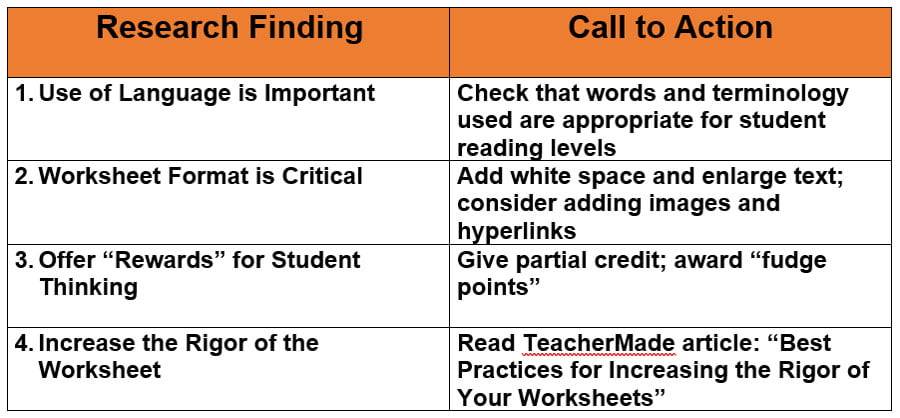Are you looking for the Classworks Special Education program from TouchMath? Click here to go to their site.
Are you looking for the Classworks Special Education program from TouchMath? Click here to go to their site.
In this article I will show why worksheets, when designed effectively, are the most efficient way for the Teacher to influence and impact student learning in their classroom. Education tools that are essential to the classroom often support one of the three stages of the education cycle. Think of education as a continuous loop, with three main activities defining this circuitous cycle:
Most educational technologies focus on one or two stages of the education cycle. For example, textbooks are mainly used for instruction but may include materials for practice. Accelerated Reader is a popular tool that focuses mainly on basic reading assessments. Online games like Kahoot or Quizizz mainly offer practice but might be considered a form of assessment.

But what fits into every stage of the education cycle so well that it’s ubiquitous across grades, subjects, and countries?? The humble worksheet.
Why? Because worksheets are agents of the Teacher. Worksheets extend the lesson, amplify the Teacher’s expertise, and transcend the classroom. Time constraints and the ratio of pupils to Teachers make it impossible to work one-on-one with every student each day. Through worksheets, the students take a piece of their teachers with them. They can apply and exercise their new knowledge at home, in study halls, in small groups, or even on the bus. When they turn in their worksheets, teachers formatively assess the student’s work and gain a view into their attainment levels, just as if they’d been personally watching over their shoulders.
According to Merriam-Websters Online Dictionary, the first known use of the term “worksheet” was in 1892. The word was coined to identify “a sheet of paper on which are printed exercises and problems to be solved by a student.” 130 years later, the term worksheet is applied to all kinds of activities that students engage in:
The humble worksheet has been elevated to a starring role in a kaleidoscope of activities that take place in the modern classroom. “Worksheet” is now a catch-all term applied to learning endeavors throughout the education cycle.
Over the past decade, as test scores have flattened out, education reformers are increasingly focusing on classroom practices to explain why high-stakes testing hasn’t been the panacea they promised. (A bit cynical? Maybe…) As a result, worksheets, open educational resources, and other teacher-created materials are regularly being disparaged.
As a practitioner, don’t let anyone stigmatize the use of worksheets in your classroom. They’re far too versatile in the education cycle to be deprecated. Though there’s validity to the criticism being levied, it’s usually directed at those worksheets that fit the 1892 definition of the word. To be certain your worksheets fit into expectations for the contemporary classroom, there are some steps you can take. Applying a critical eye and a few tweaks can take your worksheets to a more rigorous and engaging level.
1. Use of language is important: As uncovered in Dr. Che-Di Lee’s 2014 research, there is a strong correlation between reading achievement levels and effective worksheets. Check that the words used in the instructions as well as the activities are at the reading level of all who will receive the materials.
This is especially true in subjects such as science, which rely on terminology that many students may not have internalized yet. If you’re using TeacherMade to give worksheets to your students, consider adding a text box with synonyms for words that may be challenging, thereby lowering the language demand of the activity. TeacherMade will even let you add a link to a dictionary definition or a recording of your voice explanation.
2. Format of the worksheet is critical: According to Lesley and Labbo (2003), the size of the print and the spaces allotted for students to write in can negatively impact learning. Though their research focused on special needs students, it reveals a best practice all students can benefit from.
If you think that one of your PDF worksheets could use a makeover, use the Windows snipping tool (Windows key + Shift + S) to lift questions from the file. Then paste the image from your clipboard into e.g. MS Word, Google Docs, or Paint. Stretch the object so it’s larger and easier to read. Space out multiple enlarged objects down your page so there’s more white space in between. Save the file as a PDF. Then load it into TeacherMade to assign to your students for online completion.
When Lesley and Labbo were doing their research, the digital revolution was just gaining steam. Nowadays, there are also many ways to enhance your worksheets digitally, thereby grabbing your students’ attention. Consider adding images, hyperlinks, and voice recordings or letting your students do so. (You can do all of these things in the TeacherMade app.) Removing formatting obstacles and increasing a student’s desire to engage are positive strategies for elevating the effectiveness of your worksheet.
3. Offer ways to reward your students: Though there is often only one correct answer to a question or activity, sometimes the journey is just as important as the destination. Allow your students to show their work and reward them with partial credit as a means of encouragement. The TeacherMade app lets you insert Open Answer boxes onto a worksheet where students can type. The student also has drawing tools and highlighter pens which can be put to good use. Additionally, you can add “fudge” points to the worksheet to reward their journey, even if they didn’t quite make the destination. Every little bit helps when motivating your students and improving the efficacy of a worksheet.
4. Increase the rigor of the worksheet: Increased rigor of a task presents students with greater challenges to apply their knowledge and skills. By increasing the rigor, students are forced to actively engage with the task. They can’t use passive strategies, like matching keywords in the task with those in the textbook, and succeed.
They have to analyze, examine, apply, and explain. Check out this article for a rubric you can use to evaluate the DOK and cognitive rigor of your worksheet activities. (In the TeacherMade app, you can change the wording of any worksheet to increase its rigor without having to re-type the entire sheet.
